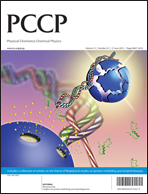Control of molecular orientations of poly(3-hexylthiophene) on self-assembled monolayers: molecular dynamics simulations†
Abstract
We theoretically investigate the energetically favorable orientation of poly(3-hexylthiophene) (P3HT) on self-assembled monolayers (SAMs) using molecular dynamics simulations. The effects of different kinds of SAMs are studied by examining a CH3-terminated SAM with a hydrophobic surface and an NH2-terminated SAM with a hydrophilic surface. We also investigate dynamic behavior of the systems with limited numbers of P3HT molecules on the SAM surfaces. The important factors in controlling the molecular orientation are elucidated from these results. We demonstrate that the edge-on orientation is more energetically favorable than the face-on orientation on both SAMs. On the other hand, the face-on orientation gains more intermolecular interaction energy between the P3HT molecules and the SAMs. This energy gain is larger in the NH2-terminated SAM than the CH3-terminated SAM. A limited number of P3HT molecules


 Please wait while we load your content...
Please wait while we load your content...